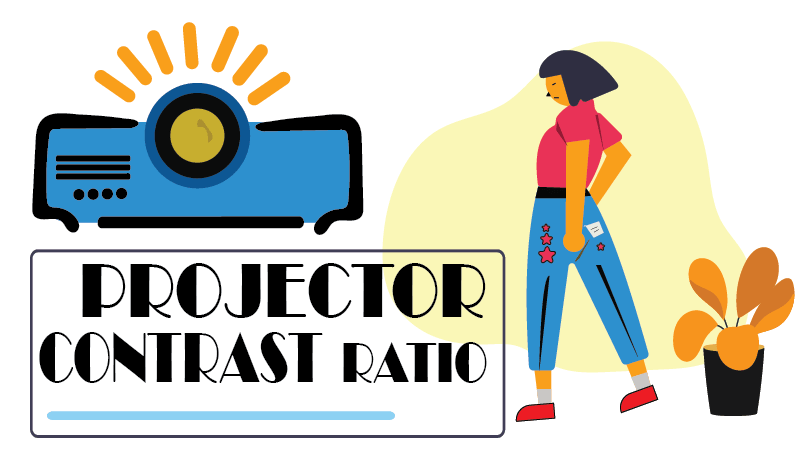
Now that you have your projector mounted, getting your projector settings right will guarantee you the best viewing experience. Therefore, a particular feature you should note is the projector contrast ratio.
If your projector is a high definition one or perhaps has a 4K or 1080p resolution, it will be irrelevant with a poor contrast ratio. Thus getting this right is essential to ensure your projector projects a bright, crispy, and detailed picture.
So what is the Projector Contrast Ratio?
The projector contrast ratio is the reflection of light from a wholly white and black image.
To better understand this, here is another definition. It is the brightest white in contrast to the darkest black, translating to a sharper projected image with all the tiny details crystal-clear.
You can also see the projector contrast ratio as the difference between light and dark images on a projector screen expressed in figures. Hence, comparing the luminosity of the brightest white and the darkest black on a screen is the contrast ratio.
To put it in figures, here is an example.
A projector with a 1500:1 contrast ratio means that the whitest white is 1500 times brighter than the darkest black.
So, a projector with a high contrast ratio will mean that the projected images will have crystal-clear details. That is what an excellent contrast is all about, seeing the details.
With this explanation, the concept of the projector contrast ratio should be clear now.
Let me go further into this critical feature of a projector.
How To Get a Good Contrast Ratio?
Having described what a projector contrast ratio is, next is how to get a good contrast ratio.
It hugely depends on the lighting conditions of your room.
Trust me, the biggest enemy to the contrast ratio of a projector is any light not coming from the projector itself.
Imagine you intended to project images in a room with a lot of ambient light. Perhaps an office space. A projector with a lower contrast ratio will offer you the best experience of that office space.
Such projectors may not suit the rooms in your home, but they will be best for conference rooms. Also, projectors have large enclosures that increase the cooling and make its operation silent.
However, for a dark room, a projector with a higher contrast ratio is most suitable. Using such projectors in your apartment guarantees you an excellent home theatre experience.
Therefore, since light affects most projectors’ contrast ratio, it is best to minimize or eliminate it.
Here are some ways to achieve that:
- The color of your rooms, floors, and walls should be as dark as possible.
- Your windows have to be well covered.
- Then turning down the lights in the room and using projector screens rather than walls will help.
Note: A projector with high lumens( high brightness) can also reduce the light sources in your room.
The Best Way to Measure The Contrast Ratio?
There may be no standard way to measure contrast ratio for a projector because the ratings provided by their manufacturers are usually not comparable to each other.
The measurements, operations, and other variables are different.
Notwithstanding, the two methods typically used to measure the contrast ratio are Full On/Off and ANSI Contrast Patterns.
The Full-On/Off Contrast Pattern
Full-On/Off contrast patterns are easy to manipulate by manufacturers.
Therefore, the figures it produces are misleading, yet manufacturers in the industry use it.
This contrast pattern method is only a marketing strategy rather than an accurate method for measuring contrast ratio(CR).
This method cancels out the effect of the room, thus resulting in an ideal CR. The readings measure the ratio of a solid white illumination, a 100 IRE test pattern showing “full-on” and the brightness of a solid black, 0 IRE test pattern that shows “full off.”
If there is a situation whereby the contrast ratio is 10,000:1, it shows that the meter is reading the solid white as being 10,000 times brighter than the solid black. These figures may seem to show a brilliant attribute, but it is misleading.
ANSI Projector Contrast Pattern
The ANSI Contrast method uses a checkerboard-patterned test image to measure the black and white brightness values simultaneously. It is a better method of measuring the projector contrast ratio. However, when the test is in an ideal room, then the potential to include the room’s effects in the measurement is possible.
The checkerboard test image ANSI used for the measurements has 16 rectangles with eight(8) white and eight(8) black. The brightness of the white and black shapes are both measured, and the average is computed. Thus, the ratio of the readings compares the white and black blocks.
The ANSI contrast ratio is typically 1000:1 or 700:1.
Despite that, the ANSI projector contrast pattern is more difficult to manipulate compared to the Full On/Off pattern method, as its figures are lower though projector makers rarely use it. The only exception is manufacturers of projectors that market to niches of particular specialties like engineering and advertising.
Another thing is that the ANSI contrast method measures the static contrast ratio of a display on the projector, while the full-on/off measures the dynamic ratio.
Difference between Static Contrast Ratio and Dynamic Contrast Ratio
Static Contrast Ratio:
The static contrast ratio compares the brightest and darkest color the projector can produce simultaneously at any instant in time. The projector screen shows full bright on half screen and full dark on the other half while measuring the static contrast ratio. Thereby, it translates to a lower projector contrast ratio as the light will move into the screen’s darkened section and gives it a higher luminance.
Dynamic Contrast Ratio:
The dynamic contrast ratio compares the brightest and darkest colors the projector can produce over time as the picture on the screen is moving.
Measuring dynamic contrast ratio involves using two panels of the exact model that have an inbuilt dark and light spot in the factory.
What is a Dynamic Iris?
Perhaps you do not know what this term means, so let’s get the definition.
Dynamic iris is a built-in feature in some projectors that lies between the lamp and the projector’s lens. The iris opens and closes to let in less or more light per second after the projector determines the overall brightness of the image projected.
So when a darkened scene is projecting, the output diminishes instantly to make the black appear darker. Whereas for bright images, the output is more luminous. The function the dynamic iris does in a projector happens in seconds that you may not notice it.
This feature affects the full-on/off contrast ratings as the whitest white with the iris opened and the blackest black as the iris is closed are strong determinants. However, the dynamic iris does not affect ANSI contrast, but a projector with a lower contrast rating appears higher in contrast in either a dark or bright scene.
Conclusion
Projector manufacturers understand the sensitivity of buyers about the contrast ratio and leverage it. They increase the projector contrast ratio to unreasonable levels to only stay competitive.
Therefore, you must take the official contrast ratio specifications for most projectors with a pinch of salt because the specs can mislead you, as already stated in this article.

